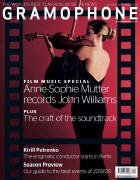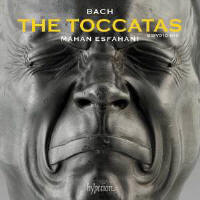Texte paru dans: / Appeared in: |
|
|
Outil de traduction (Très approximatif) |
|
|
Reviewer: Patrick Rucker
The element most characteristic of the toccata – from the earliest lute and
keyboard pieces in 16th-century Italy to more recent examples by composers as
varied as Vierne, Ravel, Debussy, Vaughan Williams, Britten, Prokofiev,
Kabalevsky, Kapustin and Adams – is the spirit of improvisation. And surely it
is an air of spontaneity that unites the seven formally diverse Toccatas of
Bach, thought to have been composed at Weimar when he was still in his twenties.
Mahan Esfahani, the Iranian-American harpsichordist now based in Prague, has
chosen the Toccatas as the first release of his renewed relationship with
Hyperion (having decamped temporarily to DG). He plays a 2018 harpsichord from
the workshop of Jukka Ollikka in Prague, after Michael Mietke, ‘with the
hypothetical addition of an extra soundboard for the 16' register and a cheek
inspired by Pleyel, 1912’. In the abstruse booklet notes, Esfahani cites some 18
sources he used to compile his own ‘variorum’ text for the recording. Rather than exultation in the grandeur of open D major sonorities at the beginning of BWV912, we hear a hectic pile-up of descending chords, devoid of sensuality or breathing space. The ensuing Allegro speaks more of crafty ill-temper than rustic jauntiness. The gripping pathos of the Adagio of BWV913 is obscured by weirdly elaborate couplings which result in muddy sonorities. Rigidly sharp-edged, jabbing figurations in the fugal finale of BWV914 have more in common with the uncompromising angles of 1950s brutalist architecture than with the fluid contours of Baroque architecture or painting. If, as some publicity has suggested, this is indeed the beginning of a series of recordings that will encompass all of Bach’s harpsichord music, we have a long road in front of us. |
|




